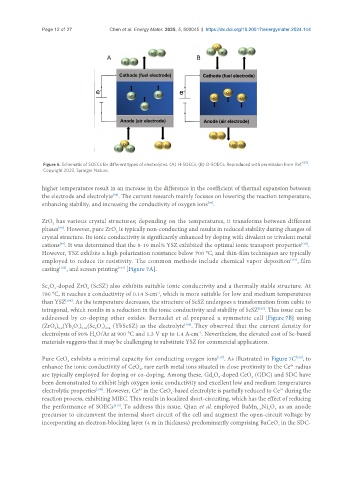Page 85 - Read Online
P. 85
Page 12 of 27 Chen et al. Energy Mater. 2025, 5, 500045 https://dx.doi.org/10.20517/energymater.2024.144
[95]
Figure 6. Schematic of SOECs for different types of electrolytes. (A) H-SOECs; (B) O-SOECs. Reproduced with permission from Ref. .
Copyright 2023, Springer Nature.
higher temperatures result in an increase in the difference in the coefficient of thermal expansion between
the electrode and electrolyte . The current research mainly focuses on lowering the reaction temperature,
[96]
enhancing stability, and increasing the conductivity of oxygen ions .
[97]
ZrO has various crystal structures; depending on the temperatures, it transforms between different
2
phases . However, pure ZrO is typically non-conducting and results in reduced stability during changes of
[98]
2
crystal structure. Its ionic conductivity is significantly enhanced by doping with divalent or trivalent metal
[99]
[100]
cations . It was determined that the 8-10 mol% YSZ exhibited the optimal ionic transport properties .
However, YSZ exhibits a high polarization resistance below 700 °C, and thin-film techniques are typically
employed to reduce its resistivity. The common methods include chemical vapor deposition , film
[101]
casting , and screen printing [Figure 7A].
[103]
[102]
Sc O -doped ZrO (ScSZ) also exhibits suitable ionic conductivity and a thermally stable structure. At
3
2
2
780 °C, it reaches a conductivity of 0.14 S·cm , which is more suitable for low and medium temperatures
-1
than YSZ . As the temperature decreases, the structure of ScSZ undergoes a transformation from cubic to
[104]
[105]
tetragonal, which results in a reduction in the ionic conductivity and stability of ScSZ . This issue can be
addressed by co-doping other oxides. Bernadet et al. prepared a symmetric cell [Figure 7B] using
(ZrO ) (Yb O ) (Sc O ) (YbScSZ) as the electrolyte . They observed that the current density for
[106]
3 0.06
3 0.04
2
2 0.9
2
electrolysis of 90% H O/Ar at 900 °C and 1.3 V up to 1.4 A·cm . Nevertheless, the elevated cost of Sc-based
-2
2
materials suggests that it may be challenging to substitute YSZ for commercial applications.
Pure CeO exhibits a minimal capacity for conducting oxygen ions . As illustrated in Figure 7C , to
[107]
[108]
2
4+
enhance the ionic conductivity of CeO , rare earth metal ions situated in close proximity to the Ce radius
2
are typically employed for doping or co-doping. Among these, Gd O -doped CeO (GDC) and SDC have
2
2
3
been demonstrated to exhibit high oxygen ionic conductivity and excellent low and medium temperatures
3+
[109]
4+
electrolytic properties . However, Ce in the CeO -based electrolyte is partially reduced to Ce during the
2
reaction process, exhibiting MIEC. This results in localized short-circuiting, which has the effect of reducing
[110]
the performance of SOECs . To address this issue, Qian et al. employed BaMn Ni O as an anode
1-x
3
x
precursor to circumvent the internal short circuit of the cell and augment the open-circuit voltage by
incorporating an electron-blocking layer (4 m in thickness) predominantly comprising BaCeO in the SDC-
3

